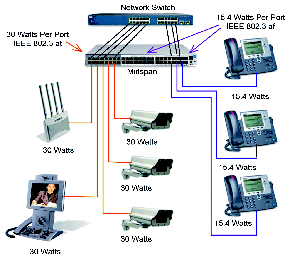
The demand for PoE solutions is growing: with the ongoing development of the PoE standard, more and more application possibilities are being generated. The planned ratification of the new, third standard POE++, for the first quarter of 2018 allows power supplies to operate with even higher outputs, up to 90W per port.
Supplying power to terminal equipment via an Ethernet interface offers crucial advantages: With PoE, no extra power connection or additional plug-in power supply is necessary for each terminal device in a network. The existing twisted-pair network cabling can thus continue to be used, and network-compatible terminal devices in an installation can be supplied with power via the data cables. With no separate power supply cable, the susceptibility to failure and deployment efforts are reduced, and with them the costs. Moreover, in the confined spaces of an installation, connected terminal devices are more easily reached without a second cable getting in the way.
Overview of the Standards
• PoE Standard: Under the first standard IEEE802.3af, each port of the power supplying equipment (PSE) delivered 15.4W. In addition, the standard also stipulated a maximum power consumption of 12.95W for a powered device (PD). To keep currents passing through the twisted pair cables as low as possible, the PoE voltage lies between 44V and a maximum of 57V.
Caution: To prevent damage to non-PoE-compatible devices, coordination of the PSE and PD is necessary. Only when the PoE compatibility and the power class of the device are recognized does the power supply make the corresponding power available. Power is supplied with cable pairs not used for data transfer.
• PoE+ Standard: With the second standard, IEEE802.3at, each port could provide 30W. However, this does not cover the power needs of many PoE applications. Producers like Phihong therefore manufactured PoE power supplies that went beyond the defined standards, delivering significantly higher power output: ultra-PoEs with 60-80W and mega-PoEs with max. 95W per port. With the higher power and data rates, common cable pairs transfer both data and power. The PoE terminal device (PD) is tasked with decoupling data from power.

Sample application: PoE midspan with multiport-hybrid-output,
sixteen ports supplying 15.4W and eight ports with 30W.
• PoE++ Standard: Work has continued on the new IEEE802.3bt standard since 2013, with ratification planned for the first quarter of 2018. The advantages: By using all four cable pairs for power, the standard allows for up to 90W per port. The standard is also compatible with the SELV criteria and LPS (Limited Power Source) according to IEC60950-1. With the standardised increase in available power, a wide range of power outputs can now be covered using PoE power supplies that can be integrated into the network (midspans or injectors). This opens up new fields of application in IT and industry.
Useful tip:
• LED lighting via PoE: The power available under the new standard and the PoE voltage of max. 57V are sufficient to address various LED applications. In the future, lamps will be increasingly fitted with sensors; they will then occupy a central position in the Internet of Things, or transfer gathered data through wires directly to facility management. PoE can supply the LED lamps and also the sensors with power, as well as transfer gathered data to the receiver.
PoE power supplies from Phihong
Phihong started work early on the issue of data and power transfer via twisted-pair Ethernet cables, and has been working to establish a standard since 1999. The company has been selling standard-compliant PoE products since 2003 and has now developed a wide range of PoE power supplies as both single-port and multiport solutions. Their multiport midspans currently provide a maximum of 806W total power.
Schukat electronic, working closely with Phihong, is currently expanding its PoE range, and offers the most popular single-port injectors and multiport power supplies in both desktop and 19" rack models direct from stock.












